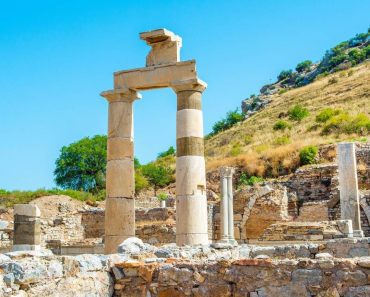
Excavations in Ephesus continue in 2024, right in the heart of Ephesus, around Domitian Square. During the latest excavation campaign in Ephesus ancient city, tabernacles were uncovered at Domitian square, as can be found lining the streets throughout the city. What was breathtaking, those tabernacles were the interiors of the commercial establishments.
Table of contents

Domitian Square Through the Ages
Initially established in the early Roman era, Domitian Square gained importance in the 5th century AD, undergoing significant transformations similar to other Ephesian public areas. It evolved into one of the most important commercial hubs of Ephesus. However, a fire brought in the 7th century, the activity to an end and led to the destruction of the buildings. However, this means that almost the entire inventory has been preserved and not only allows us to assign the individual rooms functionally but also an insight into the material culture around the years 614/615 AD.
2024 Ephesus Excavation Site Video
A Late Antique Shopping District
Analysis of the findings indicates a rich culinary scene. Two tabernacles were identified as food-related businesses: a bar and a street food stall, complete with storage rooms filled with amphoras. Fish bones found among the ruins suggest a menu featuring fish sauce and prepared mackerel. Additionally, dining ware and around a thousand bronze and three gold coins were recovered, indicating the presence of a busy eatery with facilities for food preparation.
A Hub of Craft and Trade
The area also served as a marketplace for various goods. Tools, clay and glass lamps, and religious ampoules for sale to pilgrims were among the items unearthed. A workshop in the market revealed evidence of woodcraft and the production of over 700 clay ampoules, suggesting a thriving trade hub.

A Chapter in the City’s History re-written
In all of the rooms, it became clear that after the destruction, the owners and their relatives who had previously fled did not return and searched for the items, some of which were quite valuable.
We can therefore assume that there was an abrupt military event whose aim was not robbery and looting, but rather massive destruction. This can be linked to the incursions of the Sassanids, who wanted to weaken the infrastructure of the Byzantine Empire.
The discoveries at Domitian Square are not just archaeological triumphs but key in reshaping our understanding of Ephesus’s history, indicating the end of its prosperity and the beginning of its decline.






